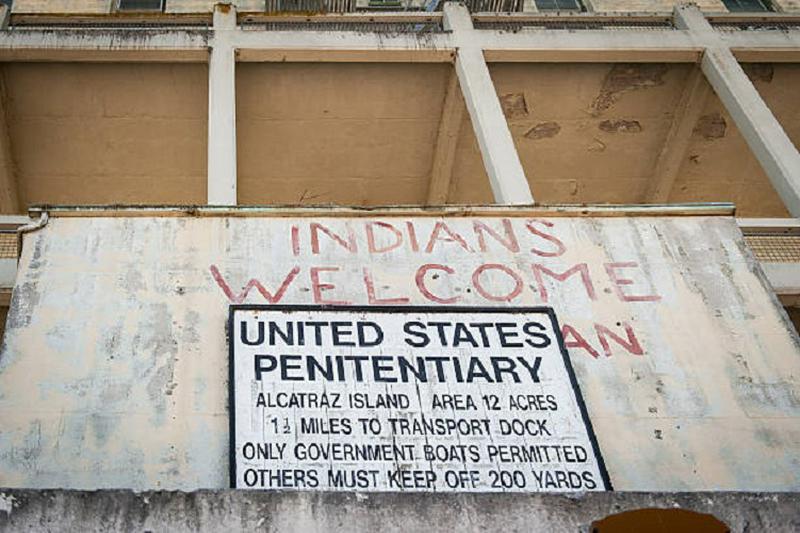When Native Americans Occupied Alcatraz
By | June 5, 2022

With the Treaty of Fort Laramie in 1868, the Black Hills were set aside for the Sioux, but according to the Indians of All Tribes (IOAT), the treaty had another provision: that all retired, abandoned, or out-of-use land was to be returned to the Indians who once occupied it.
Alcatraz Became Surplus Land In 1963
Alcatraz penitentiary was closed on March 21, 1963, and the government declared it surplus federal property in 1964. Belva Cottier, who had read about the closure, organized an occupation and court action with the goal of obtaining the title to the island. That initial occupation occurred on March 8, 1964. The 40 protestors included Sioux activists, photographers, reporters, and a lawyer. At this point, the protestors offered 47 cents per acre, for a total of $9.40 for the entire island, and they stated that the federal government could continue to use the Coast Guard lighthouse on the island. After only four hours, the protestors left as they were threatened with being charged with a felony.

The Second Occupation
As there were talks about the potential for commercial development on Alcatraz, concern grew for the availability of the island, and that coupled with the loss of the San Francisco Indian Center and tension with the U.S. government led to plans for immediate takeover. On October 9, 1969, Adam Fortunate Eagle planned a symbolic occupation, which only lasted a short while before the Coast Guard removed them. Later that day, 14 occupiers led by Richard Oakes arrived and stayed overnight; the following day, the claimed the right of discovery in a letter written by Fortunate Eagle to the General Services Administration. They then left Alcatraz.
Establishing The Community
This group was followed by a group of 89 American Indians who headed for Alcatraz on November 20, 1969. Although a Coast Guard blockade stopped most of them from landing, 14 were successful in starting their occupation, which would eventually grow to 400. After they established themselves on Alcatraz, the occupiers set up an elected council. They managed to set up a school, a daycare, and a health clinic with both doctors and nurses and everyone had a job. Native and non-Natives alike brought supplies to the island, even though the Coast Guard made it challenging to do so. To get supplies across the bay, they used canoes, and dropped supplies which were then carried up steep ladders.

At First, The Public Supported Them
One of the first occupiers was LaNada Means; she organized written speeches and was responsible for outlining the purpose of it. She made it clear that the Indians wanted complete control over Alcatraz, and they wanted to build a cultural center which included Native American Studies, a spiritual center, an ecology center, and an American Indian museum. They started making daily radio broadcasts on Radio Free Alcatraz, with John Trudell becoming “the Voice of Alcatraz.” They also started publishing a newsletter in January and managed to get celebrity support, with Grace Thorpe (the daughter of Jim Thorpe) convincing celebrities, including Jane Fonda, Marlon Brando, and Jonathan Winters, to visit the island and support the cause. Creedence Clearwater Revival donated $15,000, which they used to buy a boat.

The Occupation Begins To Fall Apart
Although Oakes had become the unofficial leader of the occupation, he was also one of the first to leave; he and Annie Oakes departed after Annie’s 13-year-old daughter, Yvonne, fell to her death. Others left because they wanted to return to school. As the members of San Francisco’s drug and hippie scene started to move there, they began restricting overnight stays on Alcatraz. The government also tried to force them to leave by shutting off the electricity often, and by making it difficult for them to get water. The Native Americans continued to try to negotiate with the American government, and in May 1970, the federal government started the process of transferring Alcatraz to the Department of the Interior and the National Park System. When LaNada left to find more support, a split occurred, and she returned to find that the remaining occupants sided with Trudell. As they struggled to raise money to buy food, they allegedly started stripping buildings of copper and selling it. The news also began publishing stories of alleged beatings and assaults, and public support began to disappear.
It Achieved Some Success
By late May 1971, the government cut off all power, and then in June, a fire destroyed several buildings on the island. On June 11, 1971, the remaining 15 occupiers were removed by government officers, ending the 19-month occupation. Although the occupiers did not achieve their goals, the government began to move towards Indian autonomy as Nixon gave his “self-determination” speech on July 9, 1970, marking an end to the policy of “termination.”